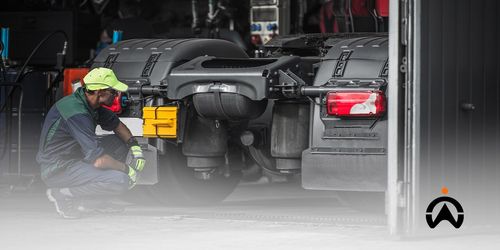How vehicle maintenance can be monitored through engine management systems
Taking care of your employees and your fleet makes a huge difference to your business. A healthy-running vehicle can benefit the business with reduced breakdowns and downtime while increasing productivity and profit.
What is vehicle maintenance?
This is the continuous process of repairing, servicing and maintaining vehicles owned by a business, an organisation and everyday motorists. The aim is to make it safer for drivers to operate these vehicles while enhancing their daily functions.
Businesses that have fleets often overlook the need for professional fleet maintenance, but many realise that it will cost them money, time, and productivity if fleet management and maintenance are not made a priority.
The importance of effective maintenance
Much like when you go to the doctor for your annual check-up, your vehicles need a similar treatment to make sure everything is running as it should. If one organ doesn’t work right, it affects the whole body, the same goes for a broken spark plug, piston rings, or cylinder head, if one thing is out of tune, it affects your entire vehicle.
Keeping up with the maintenance of your fleet can help you avoid unexpected breakdowns and unscheduled time off, which could ultimately affect the safety of your drivers and the productivity of your business.
A business will gain many advantages from adequate and proper maintenance, including:
- Fuel and financial savings as mechanical systems affect fuel consumption and efficiency
- Lowering long-term maintenance costs
- Minimising harmful exhaust emissions and protecting the environment
- Increasing vehicle dependability and lowering the risk of mechanical breakdowns or downtime
- Increasing the longevity and resale value of your vehicles
Regular servicing will also extend the life of your vehicle’s mechanical components. Keeping up with or neglecting regular vehicle maintenance can make the difference between your vehicle being safe, fuel-efficient and running smoothly or not.

Basic automotive maintenance of your vehicle
It is best to trust trained automotive professionals or mechanics with the maintenance of your vehicles in order to avoid doing it on your own. They are equipped with the skills and knowledge necessary to identify issues, fix them, and safely get you and your drivers back on the road.
Motorists and fleet drivers can sometimes take matters into their own hands by performing simple preventive maintenance such as checking water and oil levels to keep their vehicles from breaking down. To meet the car manufacturer’s recommendations, it’s usually best to keep fleet vehicles under the care of the business’ mechanics or a third-party service provider.
Engine parts that need to be checked regularly to ensure safety on the road
Depending on how damaged the vehicle might be, various internal parts have to be checked and either fixed or completely replaced.
From minor to major, check these vehicle parts for an early heads-up on any maintenance issues:
- Oil
- Tyres (ensure correct tyre pressure)
- Battery
- Air filter
- Oil levels
Finding and fixing vehicle problems early can help avoid the risk of breakdowns or accidents. These are only a few essential vehicle elements to inspect. The full list is unpacked in more detail below.
Different types of vehicle maintenance plans explained
To keep your vehicle longevity up, your car requires regular tender loving care. Car owners must pay special attention to how they maintain their vehicles.
Depending on the time of year and the season, there are several things you should check to help increase the life and performance of your car. Some of these auto parts require routine maintenance, while others only require long-term care. For clarification, the car brand can determine which parts you need to frequently inspect.
A vehicle service includes a collection of maintenance check-ups done regularly by a service centre (mandatory and specialised) and the vehicle owner, to ensure road vehicle safety.
The two most popular servicing options are:
Minor vehicle service – Taking care of your car’s minor issues, like changing the oil, oil filters and brake pads, among other things.
Major vehicle service – This includes a more extensive range of services and is much more focused than a minor service, as described in the list below.
Each of these servicing types can inspect many parts of the vehicle, including:
1. Minor servicing
- Brake & warning lights
- Front & rear brakes
- Horn inspection
- Wiper blades operation & condition
- Engine oil & leaks
- Prop shaft joints
- Tyre pressure check
2. Intermediate servicing
- Brake & clutch pedal (squeaks & adjustments)
- Brake & handbrake inspection
- Road check
- Radiator maintenance
- Battery & terminal
- Hydraulic fluid levels
- Cooling systems levels & leaks
- Fan belt inspection
- Replacement of filters
- Accelerator pedal check for throttle opening
3. Major servicing
- Dyno diagnostic test
(before & after service) - Brake & warning lights inspection
- Check all tyre pressure (spare wheel included)
- Complete road test
(rattles, wind noise, steering, straight, braking stability & noises) - Battery & terminals
- Hydraulic fluid levels
- Power steering fluid (replaced every 80 000 km)
- Gearbox levels checked & inspected for leaks
While minor servicing can be done at any time, the intermediate service should be conducted after 20 000 km, while major servicing is recommended after 40 000 km, both by skilled mechanics.

Literally trust your senses
For a more practical approach, one of the best methods of knowing about and keeping track of your car is by checking the car brand’s manual, usually located in your vehicle’s glove box.
In a business setting, your drivers can check the fleet vehicle whenever they operate it and inform their managers before any further damage is done, after all, prevention is cheaper than cure.
If you a driver has enough experience driving fleets, they can simply use their senses to identify aspects that need maintenance and report these accordingly:
Smell
Foreign smells are not a good sign. It is important to monitor any mechanical smells coming from inside the vehicle, as these can be early warning signs of a mechanical or engine issue.
Some potential causes:
- Moist smells could indicate that there are some leaking liquids, which can lead to bigger mechanical issues if not detected and resolved. Any leaking, whether moist smelling or not, is not a good sign. Quickly try to identify the source of the leak, which could be one of these liquids;
- Engine oil
- Antifreeze
- Transmission fluids
- Power steering fluid
To fix the damage, visit your local mechanic.
- A range of smokey odours could be electrical. With this, it’s best to turn off the vehicle, open the bonnet, unplug the batteries, and call your local mechanic or get professional assistance immediately.
- When the fuel tank venting becomes blocked or if there has been an overflow, fuel smells may appear.
- If your engine smells like oil or exhaust fumes, this may be caused by:
- Too much engine oil
- Oil has grown old and is burning
- Overheated oil
Sound
Strange noises while driving frequently go unnoticed due to everyday background noises like traffic, radio, passengers, etc. If the vehicle is damaged, you will hear various squeaks, squeals, bangs, and rattles each time you drive.
- Strange clicking while turning from the front wheels indicates that the front shaft is about to fall apart. Inform managers before it breaks off completely.
- A fan-belt squeal might indicate the need for another. Replacing it is the safest option.
- Rhythmic clicking while driving from the wheel could be the result of faulty bearings or, more likely, just large stones lodged in the tread pattern.
- If you have been driving steadily for a while and notice a change in engine tone, your engine is likely overheating. Stopping or varying the engine speed should be enough if there is no severe problem. Otherwise, pull over to the side of the road and let the vehicle cool before checking the water and radiator levels.
- Backfiring while driving normally indicates issues with the engine and might damage the car’s exhaust or intake. This needs to be thoroughly investigated. Reducing the speed, turning off the vehicle and immediately informing your fleet manager is the smart way to go.
- Engine knocks indicate that a lower gear needs to be selected. If it keeps happening, you should reduce speed, stop and check your engine, oil and gear shafts as soon as possible.
How often should a business service its fleet?
How often is too often? Vehicle wear and tear can often build up over time, resulting in mechanical failures, so maintaining and looking after your fleet vehicle(s) regularly is highly recommended to avoid getting into an accident.
When should you service your vehicle? This will depend on a few factors, like its age, how far it is driven each day, the surfaces and quality of the roads and sites they drive on, and how often you maintain it.
Using your vehicle in poor operating conditions will also be a determining factor. These circumstances include risky driving at high speeds, frequent stopping and starting of the car, and towing of caravans and/or loaded trailers. A vehicle used in these circumstances might need more maintenance than one that is only driven short distances and doesn’t operate frequently.
The majority of vehicles also have a maintenance schedule, and different manufacturers may have different maintenance schedule requirements. These recommended service times and maintenance procedures may be found in the vehicle’s service book.
In the world of transportation and logistics, you can’t always check on the status of every vehicle in your business. A fleet management system is often the answer for easy monitoring and tracking of fleet vehicles. The onboarded software can keep up with your business regardless of the fleet size and inform the manager of which vehicles require mechanical attention.
Importance of fleet management systems in vehicle maintenance
The purpose of a fleet management system is to assist with vehicle maintenance to ensure it is used efficiently so the lifespan of the vehicle can be maximised.
Vehicle maintenance, unfortunately, comes with inevitable downtime. Because of this, fleet managers often work to find the balance between planning and managing vehicle maintenance. Fleet maintenance management software can help with this, efficiently managing downtime while reducing costs.
To keep your vehicles on the road for longer, your car requires regular love and care, so car owners must pay special attention to how they maintain their vehicles.

Fleet maintenance software and its role
Fleet maintenance software is a fleet application that offers actionable insights concerning vehicle diagnostics, safety, risky or unsafe driver behaviour, fuel consumption, and so much more.
Maintenance software forms part of the fleet management system that handles everything from ensuring assets are kept healthy. With alerts sent to fleet managers whenever something gets damaged, informing them of what vehicle parts need to be repaired or replaced, to actively monitoring fleet use on a day-to-day basis, ensuring everything is running smoothly.
Maintenance software benefits
Out of the long list of advantages, this software provides the most popular use for fleet maintenance.
Here are additional benefits that managers can use to further improve and monitor the health of their fleet:
- Preventative maintenance
Managers can create preventive maintenance tasks like checking adjustments, cleaning, lubrication, repairs and replacements, and track when they should be performed by date, distance travelled, hours worked, or fuel used.
- Repair and upkeep
Track unforeseen repairs using the fleet platform to stay on top of them. This will help you keep track of how often your fleet gets repaired and how much repair costs are per vehicle. This can help managers assess if the vehicle is worth the frequent maintenance costs or if they should replace it and acquire a new one.
- Maintenance history
You can analyse costs and maintenance history by looking at a detailed history of the work that has been done. A thorough maintenance history offers reports on vehicle efficiency and guides you in future decision-making.
- Parts inventory
Easily manage your vehicles, assets, and parts maintenance with up-to-date information about each item’s health and whether it’s been damaged, repaired, or replaced. This can save you from unexpected breakdowns and asset downtime.
- Maintenance reporting
Reports play a key role in determining whether or not your fleet maintenance strategy is working. You can export a variety of reports or even create in-depth custom reports for your fleet, comparing one to another to see a difference in performance.

Complete fleet maintenance with Cartrack’s fleet solutions
Get automated maintenance alerts and receive licence renewal updates so you can ensure every vehicle in your fleet is well-maintained and roadworthy. Cartrack’s software solutions ensure vehicle longevity while preventing unnecessary downtime and improving productivity.
Visit cartrack.com.na for more information.




